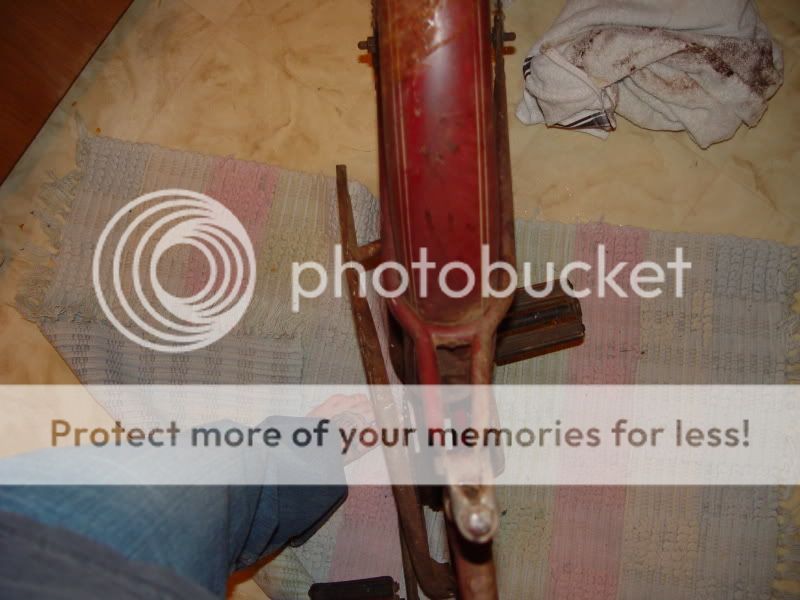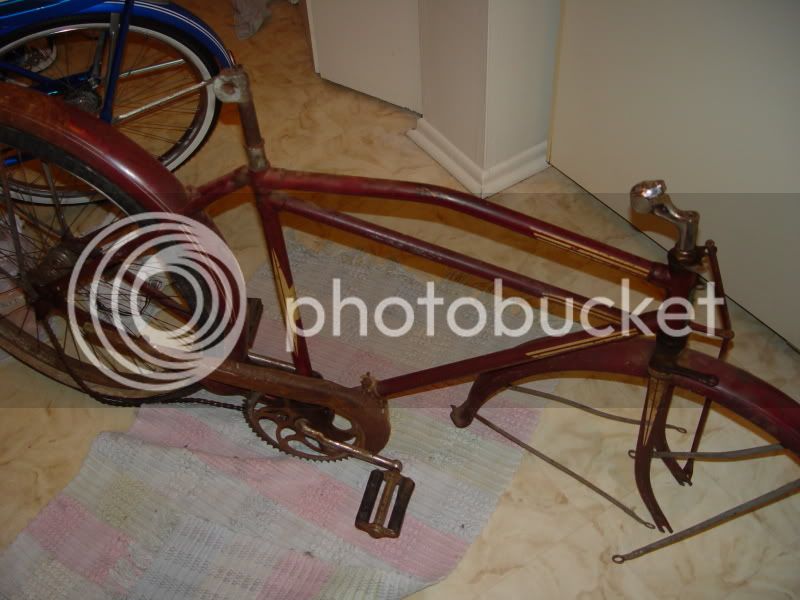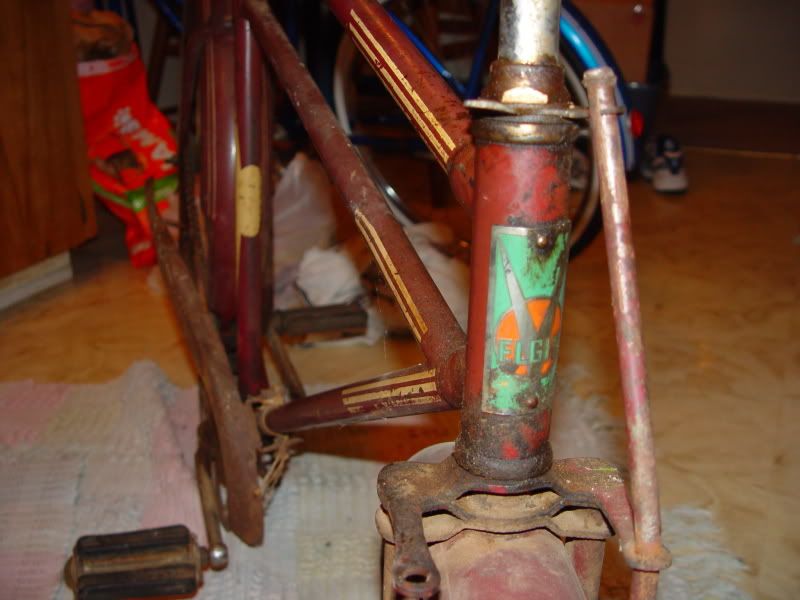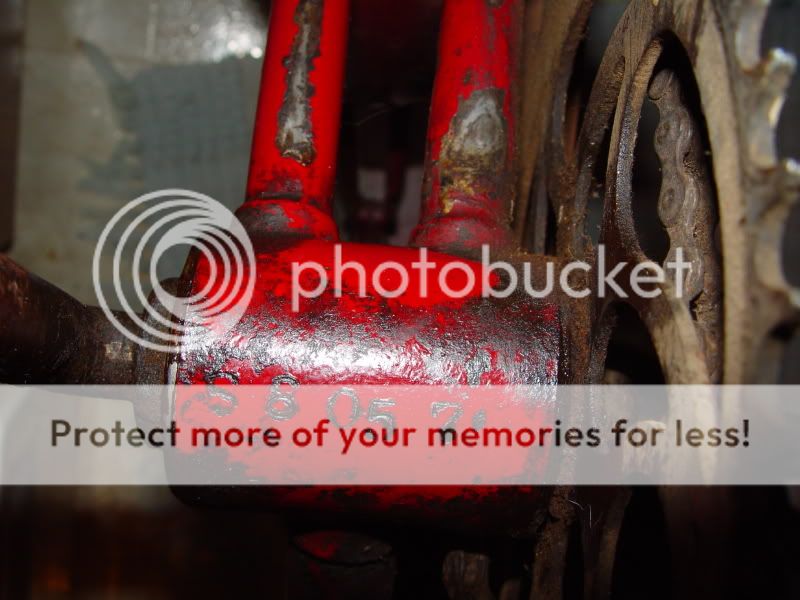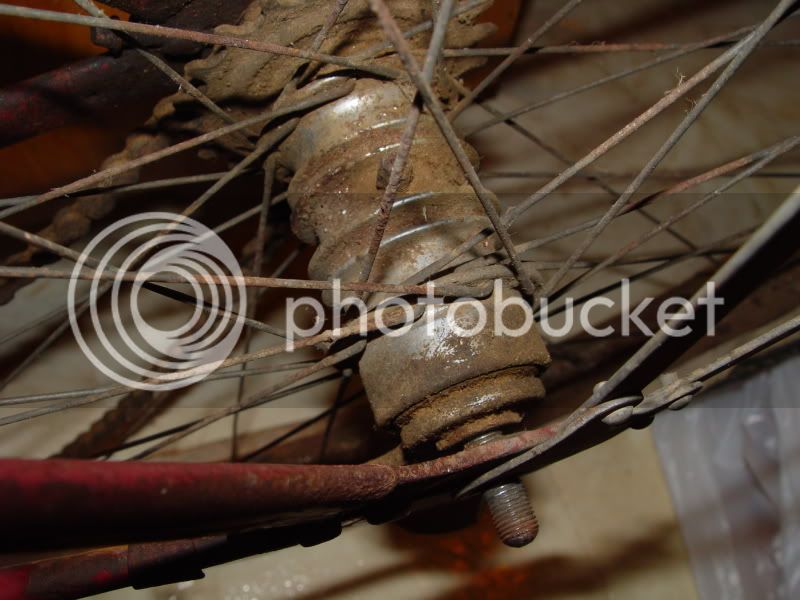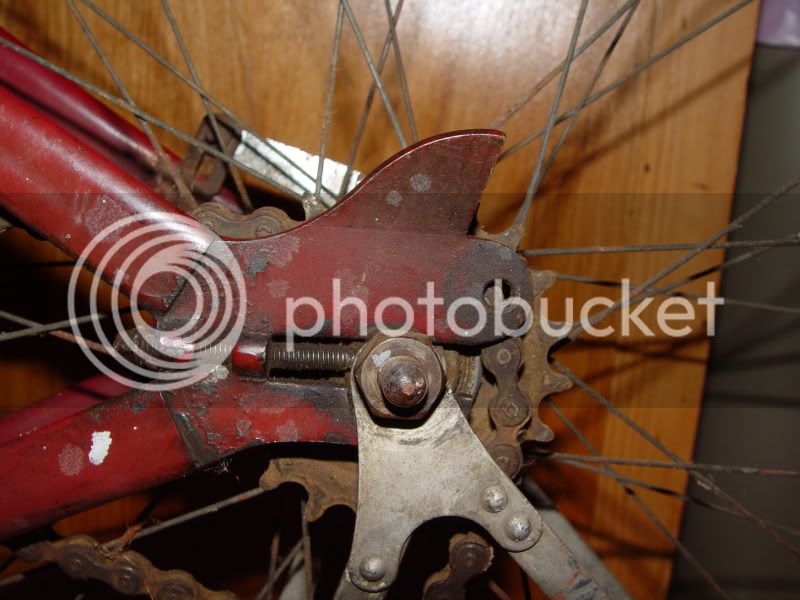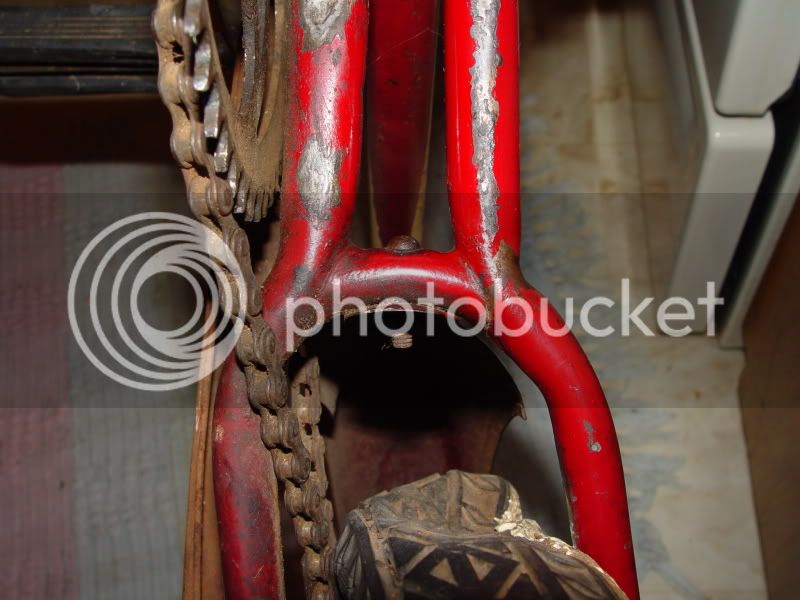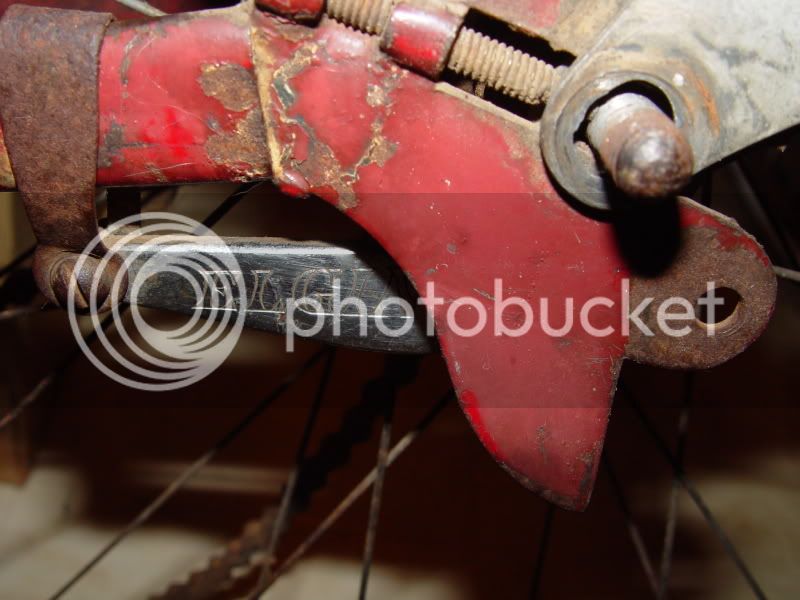You are using an out of date browser. It may not display this or other websites correctly.
You should upgrade or use an alternative browser.
You should upgrade or use an alternative browser.
yep....5hr round trip and $20 bucks
- Thread starter bikebum
- Start date

Help Support Rat Rod Bikes Bicycle Forum:
This site may earn a commission from merchant affiliate
links, including eBay, Amazon, and others.
well youve got another 30's elgin(orile this time)
heres a stock one...
http://www.nostalgic.net/pictures/63.htm
as for the rear should be fixable but better pics of the damage would help and do you have access to a torch(oxy/acetylene) and a vice?
heres a stock one...
http://www.nostalgic.net/pictures/63.htm
as for the rear should be fixable but better pics of the damage would help and do you have access to a torch(oxy/acetylene) and a vice?
It looks like the Elgin Oriel, but look at the frame closely. It's a lugged frame with strange, almost 50's style seat stays. I have never seen anything like this before.
Yes it does have a lugged frame....hmmm....and I didn't get the seat, handlebars, or one of those like bars that run in front of the fork.  And where the upper bars of the frame meet the the seat tube and neck post are slid into collars before welded....hhhmmmmm....so once I get this clean I'll post closer pics of the bike. Im glad this bike is raising eyebrows and starting some head scratching.
And where the upper bars of the frame meet the the seat tube and neck post are slid into collars before welded....hhhmmmmm....so once I get this clean I'll post closer pics of the bike. Im glad this bike is raising eyebrows and starting some head scratching.
...I tried to get that one too, ya beat me though! I have the same frame in the 28" wheel size and a lot of the parts to build it. I'm cramming balloon tires in mine.
If that frame straightens out, you'll have a really cool start for an Elgin!
(I'm in KC too, BTW)
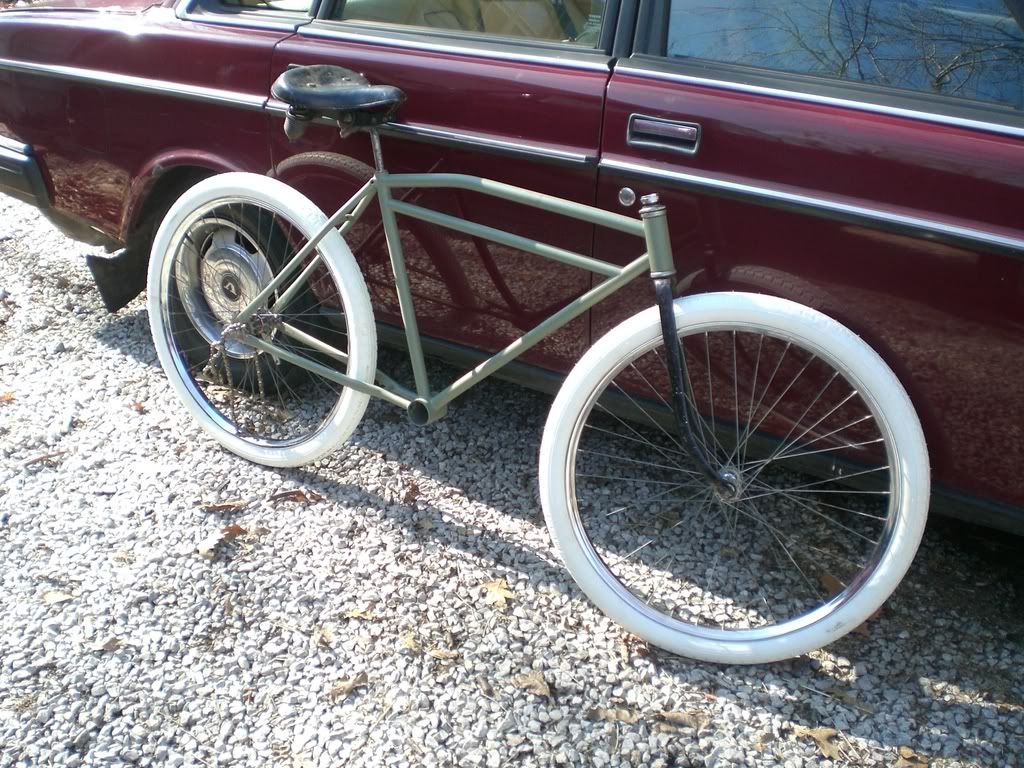
If that frame straightens out, you'll have a really cool start for an Elgin!
(I'm in KC too, BTW)

Foot tattoos......easiest place Ive even got ink done.
Skoda-I knew if I didnt get off my butt and drive to Omaha that night it would of been gone. Cool that your in KC. Is your frame like this pic below? And in my browsing I saw that you go to that club in Independence on the third Sunday of the month. Do you think theres some bars and a seat that would go with my bike floating around that club?
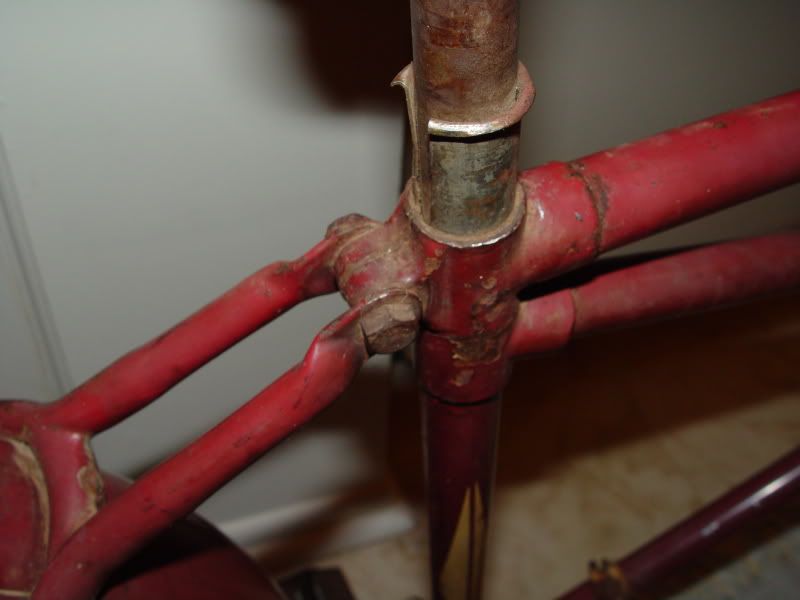
And a miss matched sprocket?
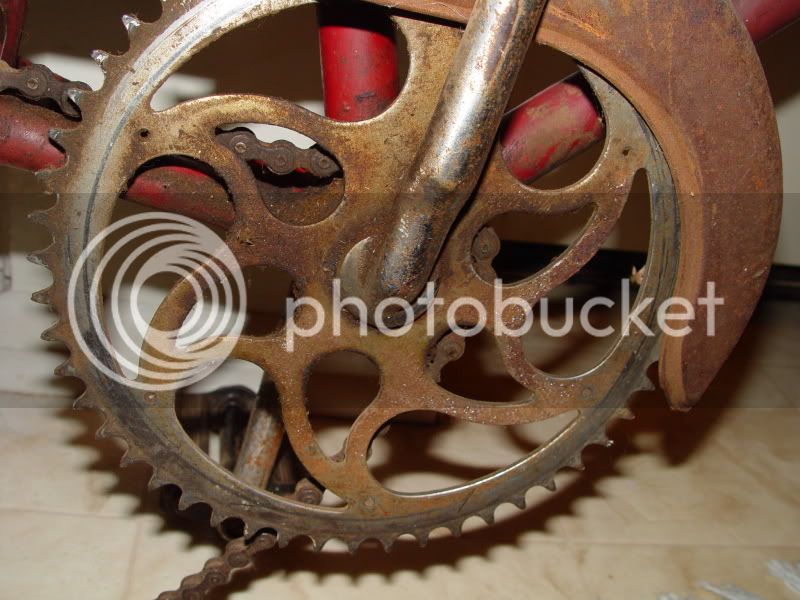
Skoda-I knew if I didnt get off my butt and drive to Omaha that night it would of been gone. Cool that your in KC. Is your frame like this pic below? And in my browsing I saw that you go to that club in Independence on the third Sunday of the month. Do you think theres some bars and a seat that would go with my bike floating around that club?

And a miss matched sprocket?

sorry about the wrong designation on that(too many beverages last night  )
)
this one youll probably be best off posting on the cabe or maybe rms37 will pop in on this one.......
for the record though that sprocket is a monark
this one youll probably be best off posting on the cabe or maybe rms37 will pop in on this one.......
for the record though that sprocket is a monark
Hi, your post came as quite a surprise for me and is reason to write a bit more than I usually do.
Your bike has surfaced at an interesting time. Last week I received an email from another collector who was trying to identify a mystery frame he had recently acquired. I didn’t recognize the frame but forwarded my opinion on what the frame might be. His frame did not have original paint and was a bare frame so there was less to go on.
Obviously the paint on your frame and very likely everything else is original.
There are a couple of detail pictures that might help pin down the manufacturer of the frame but I’ll mention a few things and some possibilities first.
As you probably know Elgin was a brand name for bicycles sold by Sears. Initially only some of Sears’ models were Elgins but after WW1 it became the house brand for all the bicycles they sold until Sears re-branded their lineup as J.C. Higgins after WW2. Sears had an in house bicycle design department for many years but did not actually manufacture bicycles. Bicycles were sourced from several manufacturers, predominantly Westfield in the early to mid thirties and then Murray Ohio beginning in 1938. While most Elgins were supplied by one of these two companies with some models sourced from both (notably the late thirties, early forties twin-bars) some bikes were sourced from other manufacturers. There are catalog pages show images of moto-balloons that are Snyder built and these turn up occasionally.
The above leads in to the fact that until I saw the pictures of your bike I had never seen that model produced by anyone but Westfield., the appearance of the mystery frame last week underlines the existence of this frame as a serial built production model but who should it be attributed to?
Back to additional photos, the three photos that would potentially help the most to determine who built this bike are a photo of the rear dropout showing the shape of the dropout and the tang or ear that act as a stop for the drop stand. Dropout plates were typically cut in-house and differ subtlety from manufacturer to manufacturer. The second photo that would be useful is a picture of the serial number (likely stamped on the bottom of the crank hanger). Lastly a picture or pictures of the bottom bracket from the offside showing the nature of the tube junctures. This is another area where individual manufacturers techniques show up.
On to speculation...
The two features that stand out are the heavy lugs used to join the frame tubes and the configuration of the seat binder.
American moto-balloons from 1932 through WW2 can be generally attributed to the following manufacturers:
Westfield
Snyder/Michigan City Excelsior
Schwinn
Shelby
Colson
Huffman
Manton & Smith
Iver Johnson
Emblem
The list above contains the name of all the American bicycle manufacturing companies that had weathered the early years of the depression and are known to have produced frames in the Moto-Balloon idiom.
To the list can be added Monark as their first aluminum frames were configured like Moto-balloons and perhaps Worksman who existed at that time but apparently mainly constructed good humor Ice cream cars.
Cleveland Welding and Murray Ohio, the two other large American bicycle manufacturers, entered the business after styles had changed and to the best of my knowledge never produce Moto-Balloon frames. Other smaller companies such as Evinrude or Rocket only existed for a sort time and again are not known to have produced Moto-balloon frames.
None of the listed companies are known to have built frames with the heavy lugged joints and the seat binder used on your frame. In light of that here is what I think are the best possibilities regarding who produced your frame.
Possibility 1 – Monark
My best guess at this point is Monark. Monark began bicycle production in 1934-35. The first bikes were a unique design with aluminum frames and 24” wheels. Monark branched out into steel construction offering the 5-bar Hawthorne frames in late 1937. These steel frames feature a sort of lugged construction and indeed the aluminum frames are lugged by nature of their mechanically (non-welded) construction. Your bike is likely from 1936-1937 so it may be a first go at steel frames that would predate the early 5-bars as the first steel Monark.
Monark evidence includes the chain ring and the fork crown. The bike appears to have a Monark ½” pitch chain ring, while someone else may have sourced this chain ring (see CCM, they used ½” pitch chain) it is a likely tie to Monark. The rear hub looks air cooled, if the hub and rear sprocket look untouched (better pictures needed to confirm) that would suggest the ½” pitch chain ring is original reinforcing this possibility.
Monark used a corrugated triple plate fork similar to Columbia but the top plate was different. The fork on the bike looks like the Monark version with the more rounded curve at the back. (The mystery bike has the same fork but I considered it might not have been original to the frame.)
I don’t have much on early Monark serial numbers but your serial number might be similar to the numbers I have or to other known bikes.
Possibility 2 – Westfield
Was Westfield experimenting with lugged frame construction? There is a patent to suggest this but considering the investment involved in producing a separate line of internally lugged frames and the fact that the model was already in heavy production in the standard Westfield format it is not likely. While the fork is similar to a Westfield fork the Westfield forks have a slight point at the outside of the rear curve on the top plate. If it is a Westfield I would expect the serial number follow their pattern.
Possibility 3 – CCM
Balloons for Canada. This was my second place choice to explain last week’s mystery frame. The seat binder and the thick lugs look exactly like the construction style used by Canadian Cycle and Motor (CMM) in Canada at that time although Canada never really bought into the balloon tire thing. Did Simpson Sears try to sell balloons in Canada? If not CCM for Canada, perhaps CCM or Euro production to meet Sears demand in the USA similar to German JCH’s in the 50’s. CCM serial number patterns are documented so again this should confirm or eliminate CCM.
Possibility 4 – Worksman
When I saw the mystery frame this was my first choice based on the lugs and the seat binder which are in the style of the Worksman industrial bikes that were being produced up until recently. Considering the additional info that comes with your bike I Am relegating it to dead last now but at least Worksman is still in business and perhaps someone there would know what they were up to in 1936.
So How Cool is it?
There may be someone out there who knows more about this Elgin variant than I do or has a pile of them in his barn. Since both the owner of the mystery frame and myself are both surprised to see this bike I have to think it is quite uncommon and important in that it adds a new twist in the Complete Elgin/Moto Balloon story.
I think that you have found a significant missing link and the highest value lies there. The fact that two of these frames have surfaced means they are now documented and that hobbyists will be looking to find more examples.
In and of itself, the lugged construction is in my opinion (others may prefer it) is less attractive than the standard model and the frame is badly bent. What your bike has going for it is that it is virtually complete and has quite nice original paint. I think the bike has very high collectible value as an historic side note which probably equates to very good trade value on the collector side of the hobby. To maintain the highest value in that direction I would be inclined to leave it as is and not attempt to straighten it or build it as a functional bike. I’m sure someone would trade you straight across for the standard model in equal but undamaged condition and you might do better than that. As the bike has the above historic significance and value and little aesthetic difference from the standard variant, it is a bike where I would encourage its preservation over modification.
Thank you for posting your find as discovering and documenting these nuances is a big part of the hobby.
Phil Marshall
Your bike has surfaced at an interesting time. Last week I received an email from another collector who was trying to identify a mystery frame he had recently acquired. I didn’t recognize the frame but forwarded my opinion on what the frame might be. His frame did not have original paint and was a bare frame so there was less to go on.
Obviously the paint on your frame and very likely everything else is original.
There are a couple of detail pictures that might help pin down the manufacturer of the frame but I’ll mention a few things and some possibilities first.
As you probably know Elgin was a brand name for bicycles sold by Sears. Initially only some of Sears’ models were Elgins but after WW1 it became the house brand for all the bicycles they sold until Sears re-branded their lineup as J.C. Higgins after WW2. Sears had an in house bicycle design department for many years but did not actually manufacture bicycles. Bicycles were sourced from several manufacturers, predominantly Westfield in the early to mid thirties and then Murray Ohio beginning in 1938. While most Elgins were supplied by one of these two companies with some models sourced from both (notably the late thirties, early forties twin-bars) some bikes were sourced from other manufacturers. There are catalog pages show images of moto-balloons that are Snyder built and these turn up occasionally.
The above leads in to the fact that until I saw the pictures of your bike I had never seen that model produced by anyone but Westfield., the appearance of the mystery frame last week underlines the existence of this frame as a serial built production model but who should it be attributed to?
Back to additional photos, the three photos that would potentially help the most to determine who built this bike are a photo of the rear dropout showing the shape of the dropout and the tang or ear that act as a stop for the drop stand. Dropout plates were typically cut in-house and differ subtlety from manufacturer to manufacturer. The second photo that would be useful is a picture of the serial number (likely stamped on the bottom of the crank hanger). Lastly a picture or pictures of the bottom bracket from the offside showing the nature of the tube junctures. This is another area where individual manufacturers techniques show up.
On to speculation...
The two features that stand out are the heavy lugs used to join the frame tubes and the configuration of the seat binder.
American moto-balloons from 1932 through WW2 can be generally attributed to the following manufacturers:
Westfield
Snyder/Michigan City Excelsior
Schwinn
Shelby
Colson
Huffman
Manton & Smith
Iver Johnson
Emblem
The list above contains the name of all the American bicycle manufacturing companies that had weathered the early years of the depression and are known to have produced frames in the Moto-Balloon idiom.
To the list can be added Monark as their first aluminum frames were configured like Moto-balloons and perhaps Worksman who existed at that time but apparently mainly constructed good humor Ice cream cars.
Cleveland Welding and Murray Ohio, the two other large American bicycle manufacturers, entered the business after styles had changed and to the best of my knowledge never produce Moto-Balloon frames. Other smaller companies such as Evinrude or Rocket only existed for a sort time and again are not known to have produced Moto-balloon frames.
None of the listed companies are known to have built frames with the heavy lugged joints and the seat binder used on your frame. In light of that here is what I think are the best possibilities regarding who produced your frame.
Possibility 1 – Monark
My best guess at this point is Monark. Monark began bicycle production in 1934-35. The first bikes were a unique design with aluminum frames and 24” wheels. Monark branched out into steel construction offering the 5-bar Hawthorne frames in late 1937. These steel frames feature a sort of lugged construction and indeed the aluminum frames are lugged by nature of their mechanically (non-welded) construction. Your bike is likely from 1936-1937 so it may be a first go at steel frames that would predate the early 5-bars as the first steel Monark.
Monark evidence includes the chain ring and the fork crown. The bike appears to have a Monark ½” pitch chain ring, while someone else may have sourced this chain ring (see CCM, they used ½” pitch chain) it is a likely tie to Monark. The rear hub looks air cooled, if the hub and rear sprocket look untouched (better pictures needed to confirm) that would suggest the ½” pitch chain ring is original reinforcing this possibility.
Monark used a corrugated triple plate fork similar to Columbia but the top plate was different. The fork on the bike looks like the Monark version with the more rounded curve at the back. (The mystery bike has the same fork but I considered it might not have been original to the frame.)
I don’t have much on early Monark serial numbers but your serial number might be similar to the numbers I have or to other known bikes.
Possibility 2 – Westfield
Was Westfield experimenting with lugged frame construction? There is a patent to suggest this but considering the investment involved in producing a separate line of internally lugged frames and the fact that the model was already in heavy production in the standard Westfield format it is not likely. While the fork is similar to a Westfield fork the Westfield forks have a slight point at the outside of the rear curve on the top plate. If it is a Westfield I would expect the serial number follow their pattern.
Possibility 3 – CCM
Balloons for Canada. This was my second place choice to explain last week’s mystery frame. The seat binder and the thick lugs look exactly like the construction style used by Canadian Cycle and Motor (CMM) in Canada at that time although Canada never really bought into the balloon tire thing. Did Simpson Sears try to sell balloons in Canada? If not CCM for Canada, perhaps CCM or Euro production to meet Sears demand in the USA similar to German JCH’s in the 50’s. CCM serial number patterns are documented so again this should confirm or eliminate CCM.
Possibility 4 – Worksman
When I saw the mystery frame this was my first choice based on the lugs and the seat binder which are in the style of the Worksman industrial bikes that were being produced up until recently. Considering the additional info that comes with your bike I Am relegating it to dead last now but at least Worksman is still in business and perhaps someone there would know what they were up to in 1936.
So How Cool is it?
There may be someone out there who knows more about this Elgin variant than I do or has a pile of them in his barn. Since both the owner of the mystery frame and myself are both surprised to see this bike I have to think it is quite uncommon and important in that it adds a new twist in the Complete Elgin/Moto Balloon story.
I think that you have found a significant missing link and the highest value lies there. The fact that two of these frames have surfaced means they are now documented and that hobbyists will be looking to find more examples.
In and of itself, the lugged construction is in my opinion (others may prefer it) is less attractive than the standard model and the frame is badly bent. What your bike has going for it is that it is virtually complete and has quite nice original paint. I think the bike has very high collectible value as an historic side note which probably equates to very good trade value on the collector side of the hobby. To maintain the highest value in that direction I would be inclined to leave it as is and not attempt to straighten it or build it as a functional bike. I’m sure someone would trade you straight across for the standard model in equal but undamaged condition and you might do better than that. As the bike has the above historic significance and value and little aesthetic difference from the standard variant, it is a bike where I would encourage its preservation over modification.
Thank you for posting your find as discovering and documenting these nuances is a big part of the hobby.
Phil Marshall
Thanks for the additional photos,
I read the serial number as S 8057
Here is an excerpt from the CCM serial number list:
1930 P12345
1931 S12345
1932 T12345
1933 U12345
1934 W12345
1935 X12345
1936 Z12345
1937 1A2345
1938 1B2345
The paint pattern on your bike was introduced by Sears at the end of 1935 and the crescent fenders date to mid 1936 and later.
With that (and the balloon tires) in mind, the bike is definitely later than 1931 so this eliminates CCM.
The serial number also eliminates Westfield as a typical 1936 serial number would begin with an “A”.
I can’t speak to Worksman serial numbers but so far the possibility of the frame being produced for Sears by Monark looks the most likely, I’ll try to get out to the pile tonight and photograph an early steel Monark dropout for comparison and post it tonight or tomorrow.
Thanks again
Phil
I read the serial number as S 8057
Here is an excerpt from the CCM serial number list:
1930 P12345
1931 S12345
1932 T12345
1933 U12345
1934 W12345
1935 X12345
1936 Z12345
1937 1A2345
1938 1B2345
The paint pattern on your bike was introduced by Sears at the end of 1935 and the crescent fenders date to mid 1936 and later.
With that (and the balloon tires) in mind, the bike is definitely later than 1931 so this eliminates CCM.
The serial number also eliminates Westfield as a typical 1936 serial number would begin with an “A”.
I can’t speak to Worksman serial numbers but so far the possibility of the frame being produced for Sears by Monark looks the most likely, I’ll try to get out to the pile tonight and photograph an early steel Monark dropout for comparison and post it tonight or tomorrow.
Thanks again
Phil
Cool fins on the rear drop outs, would that be any type of clue?
The shape of the rear dropout is a good clue and it eliminates several possible manufacturers. I compared it to several similar dropouts and unfortunately it is not conclusive. It is very similar to the dropouts on my 38-39 girls Monark 4-bar but not identical. The general shape is also similar to some later Murray Ohio frames and not very different from Westfield frames with drop out ears.
I was able to pull out several frames for the comparison but I ran out of time to get to the back of the pile (which is where what you want always calls home) and to take photographs. I will get back on this tomorrow but we’re out the door for Thanksgiving in the next hour.
Seasons best to everyone
Phil
I was able to pull out several frames for the comparison but I ran out of time to get to the back of the pile (which is where what you want always calls home) and to take photographs. I will get back on this tomorrow but we’re out the door for Thanksgiving in the next hour.
Seasons best to everyone
Phil
Hi
Here are some pictures for comparison to help (?) pin down the manufacturer of your frame
The first photo is a composite showing the recently found Westfield Elgin Moto-balloon fork crown on the extreme left and your fork crown on the extreme right. In the middle a Westfield fork is shown next to a Monark fork. While similar the fork crowns are discernibly different and the fork crown on your bike matches the one used by Monark.

The second photo shows the rivet placement in a Monark Fender (left) compared to the rivet placement in a Westfield fender. The rivets don’t show in your photos but this is another thing to look at.

Lastly I have taken photos of four dropouts. The upper left is from a Westfield frame. The Westfield dropouts with ears from this period that I have looked at have a notch between the dropout slot and the drop stand hanger bulb. The dropout in the upper right is from a late Murray Ohio built Elgin. These dropouts are very different and used a special separate tensioner to pull the wheel rearward and are not stamped for the more traditional locator bolts. The bottom left is the earlier and more conventional Murray Ohio dropout and the dropout in the lower right is from a girl’s Monark 4-Bar. Colson dropouts are also similar but I didn’t get to photograph one.

At this point I would say that the chain ring and the fork point strongly toward Monark as the manufacturer. The fender bridges also are similar to those on some steel Monark frames. The heavy lugs may relate to Monark’s use of cast aluminum lugs on their aluminum frames but that is a stretch. The lugs and the seat cluster still look more like those commonly used on Canadian CCM frames (see the Massey) or later on Worksman frames.
The serial number is inconclusive but it seems to rule out Westfield or CCM as those two systems are known. The serial number has little in common with the Early Monark frames I looked at but two are from the Aluminum series an the other is a later 4-bar frame.
The dropouts are also somewhat inconclusive. While they don’t have the Westfield notch,
they are also very differently shaped than the later Monark 4-Bar dropouts.
At this point my money is on Monark, but I don't feel there is enough proof yet to be certain.
Phil
Here are some pictures for comparison to help (?) pin down the manufacturer of your frame
The first photo is a composite showing the recently found Westfield Elgin Moto-balloon fork crown on the extreme left and your fork crown on the extreme right. In the middle a Westfield fork is shown next to a Monark fork. While similar the fork crowns are discernibly different and the fork crown on your bike matches the one used by Monark.

The second photo shows the rivet placement in a Monark Fender (left) compared to the rivet placement in a Westfield fender. The rivets don’t show in your photos but this is another thing to look at.

Lastly I have taken photos of four dropouts. The upper left is from a Westfield frame. The Westfield dropouts with ears from this period that I have looked at have a notch between the dropout slot and the drop stand hanger bulb. The dropout in the upper right is from a late Murray Ohio built Elgin. These dropouts are very different and used a special separate tensioner to pull the wheel rearward and are not stamped for the more traditional locator bolts. The bottom left is the earlier and more conventional Murray Ohio dropout and the dropout in the lower right is from a girl’s Monark 4-Bar. Colson dropouts are also similar but I didn’t get to photograph one.

At this point I would say that the chain ring and the fork point strongly toward Monark as the manufacturer. The fender bridges also are similar to those on some steel Monark frames. The heavy lugs may relate to Monark’s use of cast aluminum lugs on their aluminum frames but that is a stretch. The lugs and the seat cluster still look more like those commonly used on Canadian CCM frames (see the Massey) or later on Worksman frames.
The serial number is inconclusive but it seems to rule out Westfield or CCM as those two systems are known. The serial number has little in common with the Early Monark frames I looked at but two are from the Aluminum series an the other is a later 4-bar frame.
The dropouts are also somewhat inconclusive. While they don’t have the Westfield notch,
they are also very differently shaped than the later Monark 4-Bar dropouts.
At this point my money is on Monark, but I don't feel there is enough proof yet to be certain.
Phil




